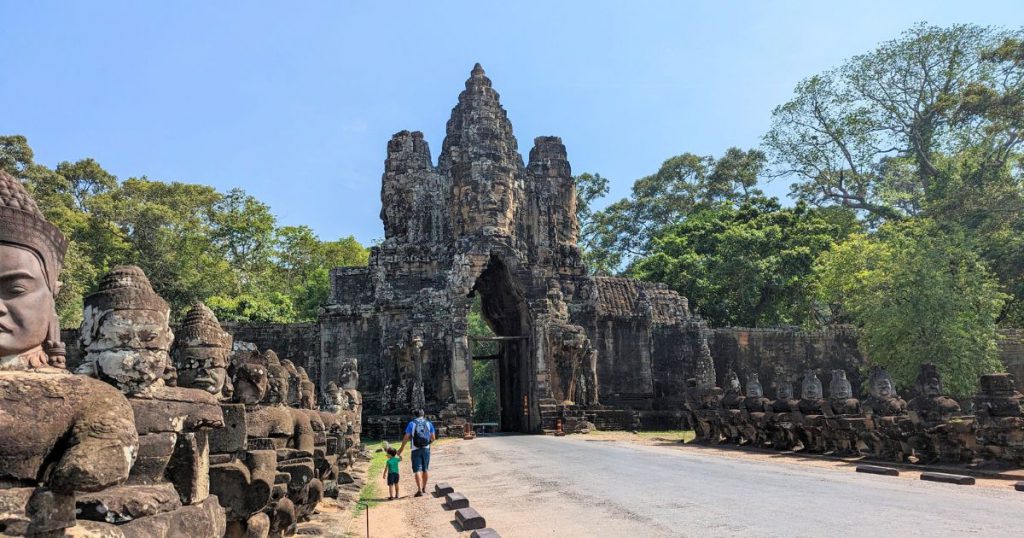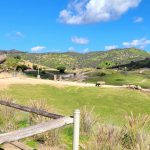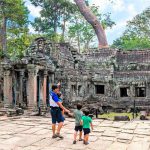This page may contain affiliate links, which means that we may earn from qualifying purchases at no additional cost to you.
A tour of the Angkor Wat Small Circuit is an absolute must-do activity for anyone visiting Siem Reap that will undoubtedly become the highlight of your stay!
The Small Circuit includes the most iconic temples of Angkor Wat Archeological Park, including the “Big Three”: Angkor Wat, Angkor Thom, and Ta Prohm.
It is true that these temples are extremely popular and can get a bit crowded, but for good reason. These temples are without question some of the most spectacular ruins you’ll find anywhere in the world.
I’ve been to some pretty impressive historic locations, but I left feeling that Angkor Wat will forever be the standard to which I hold other historical sites and ruins.
And you can see most of them in one day at Angkor Wat!
The Small Circuit is designed to be explored within a day, as the temples are relatively close to each other. This makes it a convenient option for visitors with limited time or those who prefer a condensed tour.
However, if you do have the time for it, I would highly recommend adding the Grand Circuit to your Siem Reap itinerary. The temples on the grand circuit were some of our favorites in the park and are well worth seeing. And in general, the temples on the grand circuit are less crowded than those on the small circuit, offering a more peaceful and contemplative experience.
In this article we’ll be breaking down all you need to know for a great experience visiting the Small Circuit of Angkor Wat!
Also be sure to check out our detailed Siem Reap itinerary to make the most of your stay!
What to know before taking the Small Circuit tour
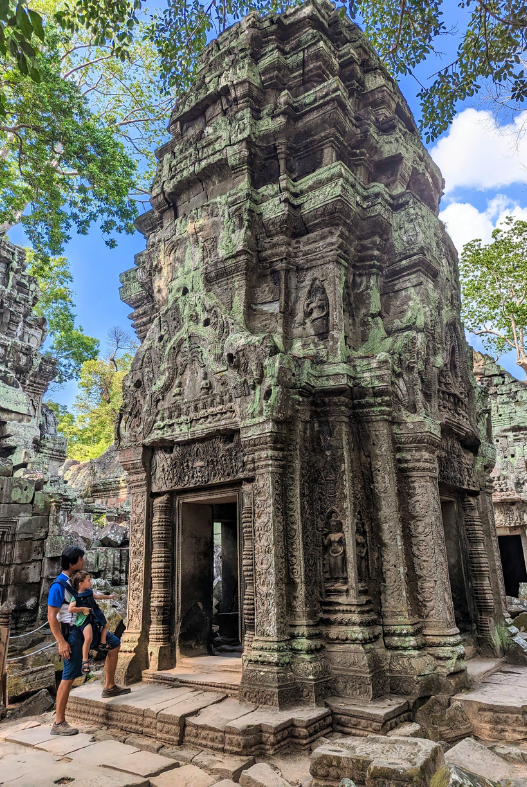

Cost
The cost of entrance to Angkor Wat depends on what kind of pass you buy. You can purchase either a 1-day, 3-day, or 7-day pass.
The multi-day passes do not need to be used on consecutive days. For the 3-day pass, you have a 10 day period to use it, whereas for the 7-day pass you have 30 days. Children under 12 are free.
Tickets can be bought either online or at the ticket office in downtown Siem Reap. The ticket office is open from 5am to 5:30pm.
- 1-day pass: $37
- 3-day pass: $62
- 7-day pass: $72
Hours
- Most of the temples: 7:30 am-5:30 pm
- Angkor Wat: 5 am-5:30 pm (open at sunrise)
- Phnom Bakheng and Pre Rup: 5am – 7pm (open at sunrise and sunset)
What is the difference between Angkor Wat small circuit and big circuit?
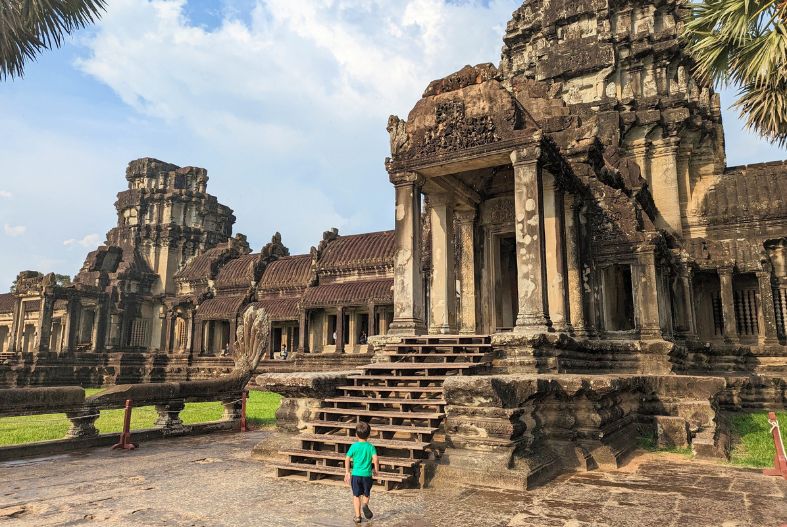

In Angkor Wat, there are two main tour circuits: the grand circuit and the small circuit.
The small circuit focuses on the most iconic and popular temples in the Angkor Wat complex.
These temples are in closer proximity to each other, making it more manageable to explore them within a day. The small circuit is an ideal choice for those with limited time or who want to visit the most renowned Angkor temples.
On the other hand, the temples in the grand circuit are located farther away from the central Angkor Wat complex, requiring more travel time between sites. The grand circuit allows visitors to discover lesser-known but equally impressive temples.
Whether you choose the grand circuit or the small circuit, both offer captivating insights into the ancient Khmer civilization and its remarkable temple complexes.
How long is the Angkor Wat Small Circuit?
The Angkor Wat small circuit is over 10 miles long (17km) and will take an entire day to explore (although you could spend longer).
The temples within the route are close together and it’s quite easy to move from one temple to the next throughout your day.
How to get around the Angkor Wat Small Circuit


There are several transportation options for exploring the small circuit. Here are a few choices.
Tuk tuk
The most popular way to get around the small circuit is by hiring a tuk tuk driver for the day. Your driver will pick you up at your accommodations and drive you to each temple, waiting for you while you explore.
Typically rates for visiting the temples are by the day. For the small circuit, you can hire a tukt uk driver for around $15 for the whole day.
Private vehicle
You can also choose to hire a driver with a private vehicle for the day. This is a bit more pricey, around the range of $45 and up, but comes with added comforts such as air conditioning and a more comfortable seating arrangement.
For the small circuit you really won’t be in the car between temples too much anyway given that they are so close together, so for most people it probably makes sense to use the cheaper tuk tuk. Plus it’s a fun cultural experience!
Bike
Another way to get around the small circuit is by renting a bike. The temples on the small circuit are close enough together that you can easily bike between them.
However, be aware that it is very hot and humid in Siem Reap and by biking between temples you won’t get much of a respite from the heat.
Temples of the Small Circuit
Angkor Wat
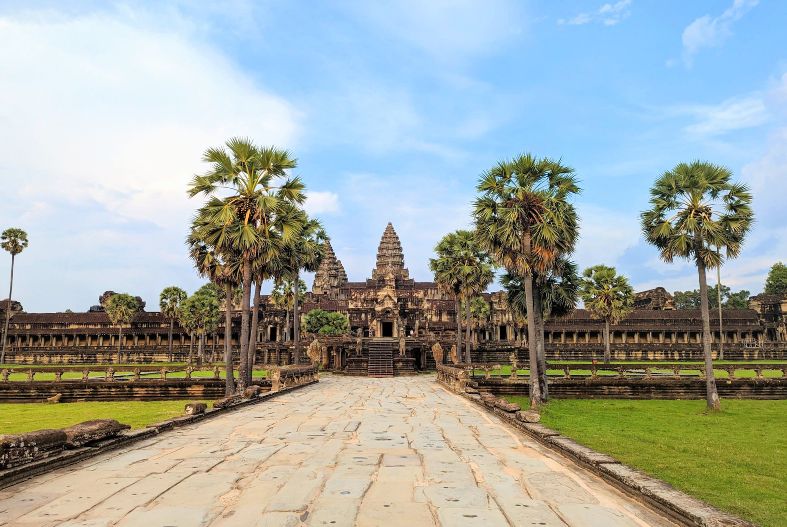

For many, the first temple they will see on a visit to Angkor Archeological Park is the iconic Angkor Wat, arguably the most famous of the temples in the complex.
If you’re up for an early morning, plan on being at Angkor Wat for the sunrise. This is the most popular spot to watch the sunrise in Angkor Archeological Park, so be sure that you get there early to secure a spot. Station yourself behind one of the pools on the grounds to get that classic shot of Angkor Wat’s reflection at sunrise.
After you catch the sunrise, head inside to explore the massive temple. Or, if you want to miss the sunrise crowd, plan on coming back and visiting Angkor Wat later in the day. No matter when you visit, you’ll want to carve out a fair chunk of time to spend in this impressive sanctuary.
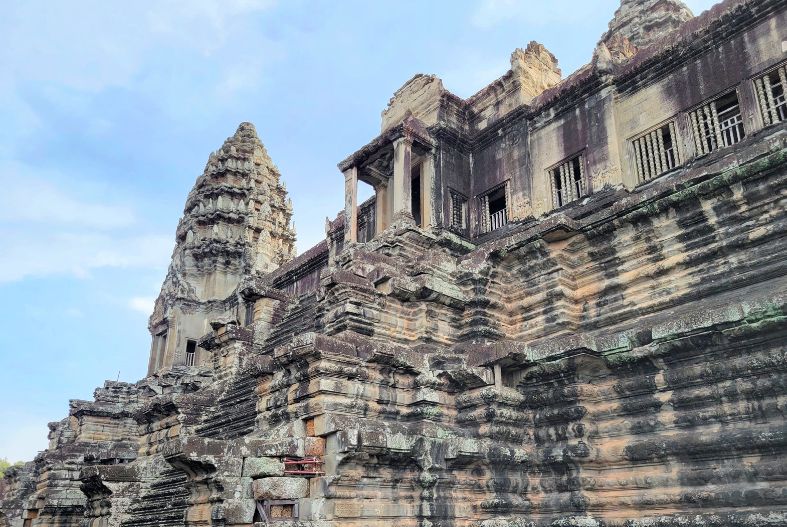

Built during the early 12th century by King Suryavarman II, Angkor Wat is the most significant religious monument in the vast Angkor Archaeological Park. Angkor Wat is considered a symbol of Cambodia and even appears on the country’s national flag.
Originally constructed as a Hindu temple dedicated to the god Vishnu, the temple later transitioned into a Buddhist temple.
The temple’s design represents Mount Meru, the mythical home of the gods in Hindu cosmology, with its five towers symbolizing the peaks of the sacred mountain.
A vast moat surrounds the temple and to reach the temple grounds you’ll cross a long bridge spanning the water.
Once you’re inside, take your time exploring the passageways and courtyards as you make your way to the center of the temple.
In the center of the temple you’ll have the opportunity to climb to the highest level, or Bakan, which is the most sacred place in the temple. From the upper level you will have incredible panoramic views of the surrounding area.


Note that there is sometimes a line to go into the Bakan and children under 12 and pregnant women aren’t allowed inside due to the steepness of the ascent.
There is a lot to take in at Angkor Wat temple, so plan on spending at least a couple of hours exploring.
Angkor Thom
Angkor Thom is not a single temple, but instead it is the location of a vast and remarkable ancient city that served as the last capital of the Khmer Empire.
Established in the late 12th century by King Jayavarman VII, Angkor Thom covers an area of about 10 square kilometers and is surrounded by an imposing wall and wide moat.
The city’s name translates to “Great City” in Khmer, and it was once a bustling metropolis with an estimated population of over one million people during its peak.
There are several points of interest that you will want to be sure to visit during your time exploring Angkor Thom, which we’ll cover below.
South Gate
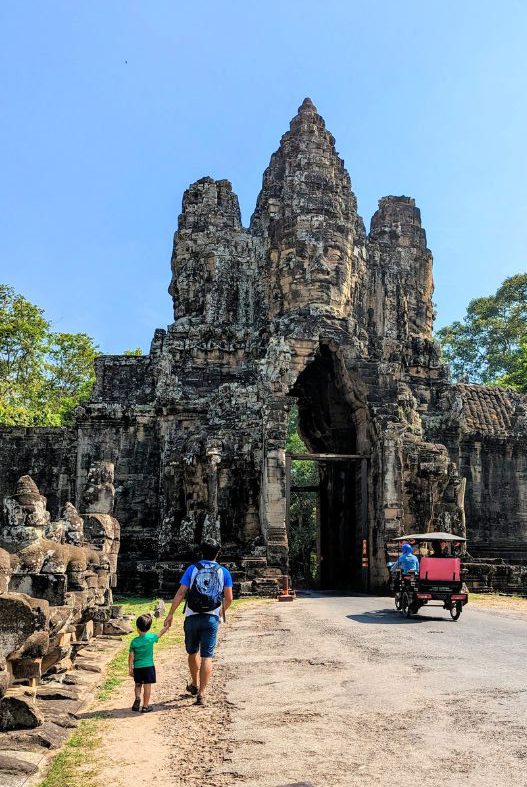

When entering Angkor Thom, you’ll have to pass through one of the five outer gates. The most famous of the gates is the South Gate, which has the best restored causeway.
The causeway leading to the gate is flanked by a grand procession of stone figures, including gods and demons holding a Naga, a mythical serpent-like creature.
The gate itself is adorned with large “Bayon-style” faces, which have become one of the most recognizable symbols of Angkor.
One way or another you will go through the gate, given that the road passes directly beneath it, but it’s worth it to get out of your vehicle and walk under the gate on foot. This gives you the chance to see the gate up close and get better pictures.
Bayon
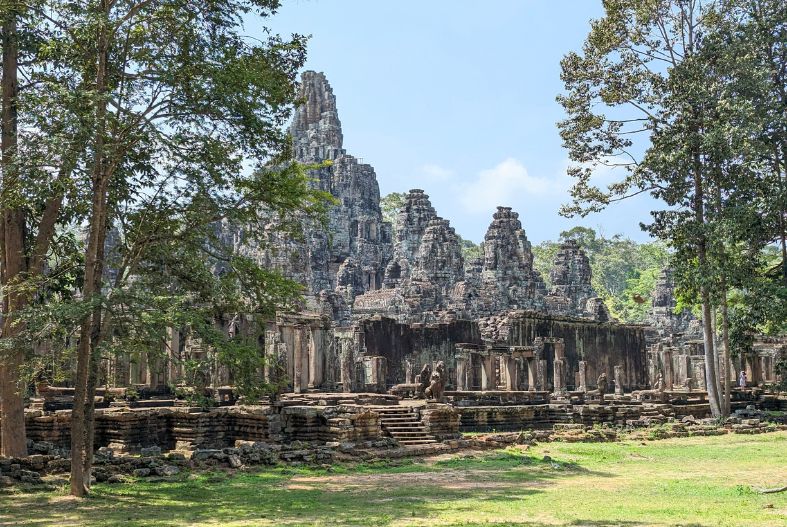

The most famous temple in Angkor Thom is Bayon Temple.
Built in the late 12th or early 13th century by King Jayavarman VII, Bayon is renowned for its distinctive architecture featuring 54 towers adorned with over 200 massive stone faces. The temple’s faces, known as the “Bayon-style” faces, gaze serenely in all directions.
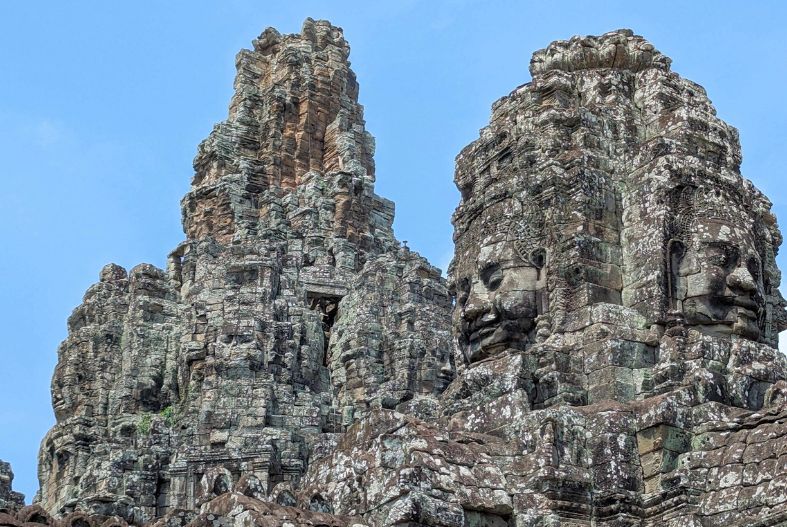

The temple is quite large and the complex layout and labyrinthine passageways make it a fascinating place to explore. It can also be a bit easy to get turned around, so there are marked tour routes throughout the temple to guide you.
There are three paths you can take through the temple, depending on how much time you want to spend. The tours range from an estimated 1 hour 45 minute tour, which takes you along the entire temple wall before venturing inside, to a 55 minute tour, which cuts through the temple and skips much of the exterior.
We chose to do the longer tour and it didn’t actually take 1 hour and 45 minutes. However we did feel that it was worth it to see more of the temple, especially the exterior walls, which are intricately carved with detailed bas-reliefs depicting scenes from Khmer history, mythology, and daily life.
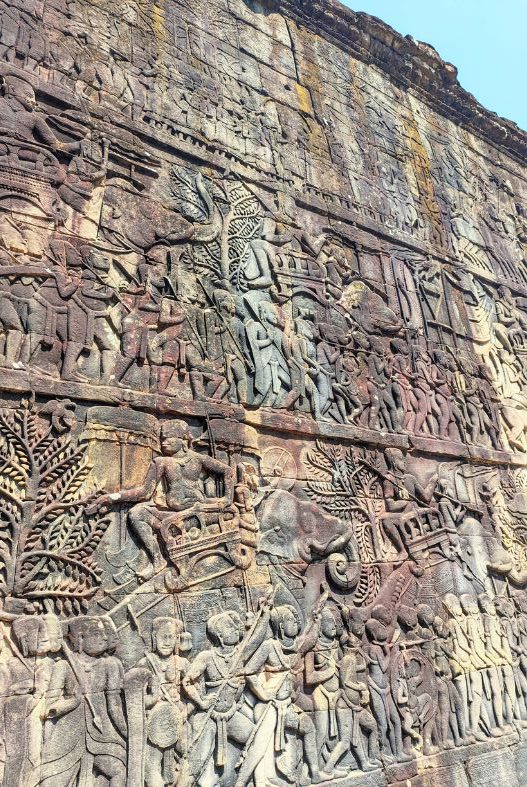

As you make your way through Bayon it is easy to see why it is one of the most recognized and photographed temples in the complex.
Baphuon
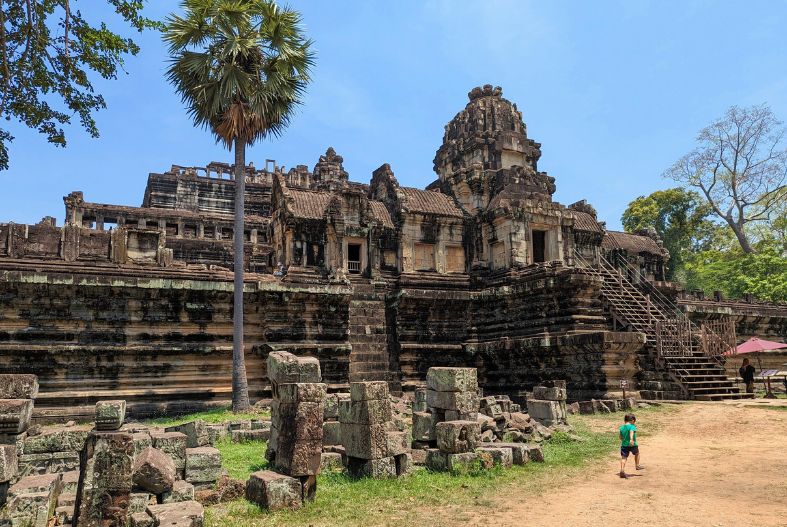

It’s only a short walk from Bayon to the mountain-temple Baphuon.
Baphuon was originally dedicated to the Hindu god Shiva and served as the state temple of the royal capital.
The temple once stood as one of the tallest and most impressive structures in Angkor, but over the centuries, it fell into disrepair and was partially dismantled.
In the 20th century, extensive restoration efforts were undertaken to revive the temple to its former glory.
Baphuon’s restoration work is an architectural feat in itself, as experts had to carefully document and reconstruct the temple’s thousands of stones like a gigantic 3D jigsaw puzzle.
Today, visitors can marvel at the sheer magnitude of Baphuon, which features a vast sandstone pyramid adorned with intricate carvings and sculptures.
Be warned before you attempt to climb this temple that it does involve some very steep sets of stairs which are a lot worse going down than going up. Children under 12 and pregnant women are not allowed to enter this temple for that very reason.
But if you do make it up the sides of the temple, the view from the top is gorgeous!
Phimeanakas
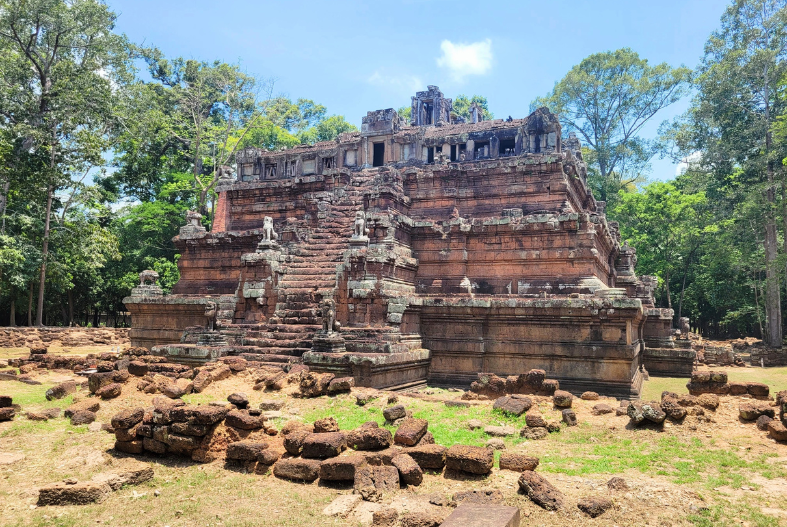

Situated within the Royal Palace area of Angkor Thom, Phimeanakas is a pyramid-shaped temple with a small sanctuary at its summit.
The temple is built of brick and laterite and was once adorned with intricate carvings, but much of its decorative elements have weathered over time.
This is a quick visit, given that you can no longer climb to the top of the temple, but it is still worth passing by on your way through the ruins.
Terrace of the Elephants


Built during the late 12th century by King Jayavarman VII, the terrace served as a platform for royal ceremonies and public events.
The name “Terrace of the Elephants” comes from the intricate carvings of elephants that adorn its walls.
The terrace is over 1000 feet long, making it one of the largest and most striking structures in the Angkor complex.
It was once part of the king’s palace and was used as a viewing platform where the king and his entourage could watch ceremonial processions and other events taking place in the adjacent Royal Square.
Terrace of the Leper King


To the north of the Terrace of the Elephants is the Terrace of the Leper King.
This terrace gets its name from the discovery of a statue on the upper platform featuring a naked figure known as the “Leper King.” This figure, carved from stone, is depicted as a skeletal, emaciated person, giving rise to the terrace’s name.
However, the true identity of the “Leper King” remains uncertain, and the figure may represent a different deity or ruler.
This is a quick visit, but it is an interesting place to spend a few minutes. The original statue of the leper king is now in a museum in Phnom Phen, but has been replaced with a replica.
Ta Prohm


After finishing with Angkor Thom, a perfect next stop is Ta Prohm, also known as the Tomb Raider temple, as it was notably featured in that film. This is a captivating temple known for its unique fusion of ancient ruins and nature.
What sets Ta Prohm apart from other temples in the complex is its picturesque appearance, with towering trees and thick vegetation engulfing its stone structures.
This blend of nature and ancient ruins has made Ta Prohm one of the most popular and photogenic sites in Angkor.


As visitors explore Ta Prohm, they can witness the remarkable intertwining of tree roots with the temple’s walls, courtyards, and corridors.
This was definitely one of our favorite temples that we visited in Angkor Wat. It’s a peaceful place to visit and much of the area is shaded, providing some relief from the heat.
We spent about an hour here, but I could have spent a lot longer exploring this charming site.
Banteay Kdei
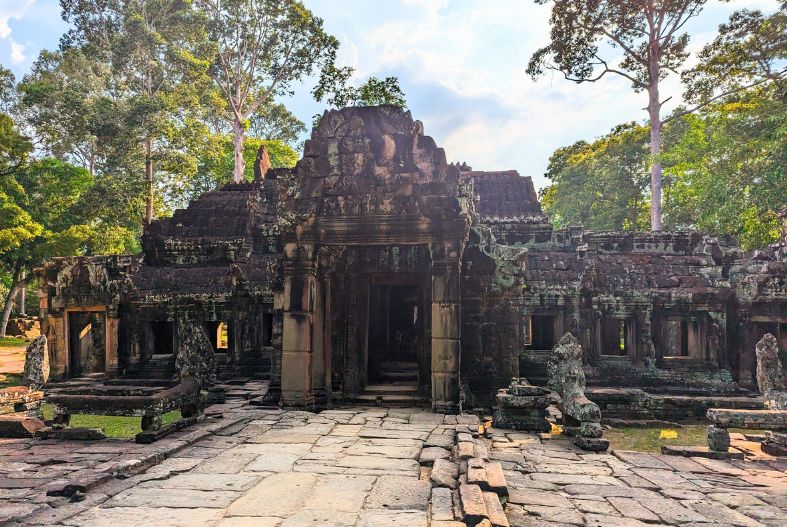

If you’re still up for a few more temples, make a stop at Banteay Kdei, located Southeast of Ta Prohm.
Built during the mid-12th century by King Jayavarman VII, Banteay Kdei was originally dedicated to Mahayana Buddhism and served as a Buddhist monastery.
The temple’s name translates to “Citadel of Chambers,” reflecting its complex and labyrinthine layout, with various interconnected enclosures and galleries.
Though located within the small circuit, this temple is much less crowded than the “Big Three”, making it an ideal place to explore without the crowds.
Srah Srang
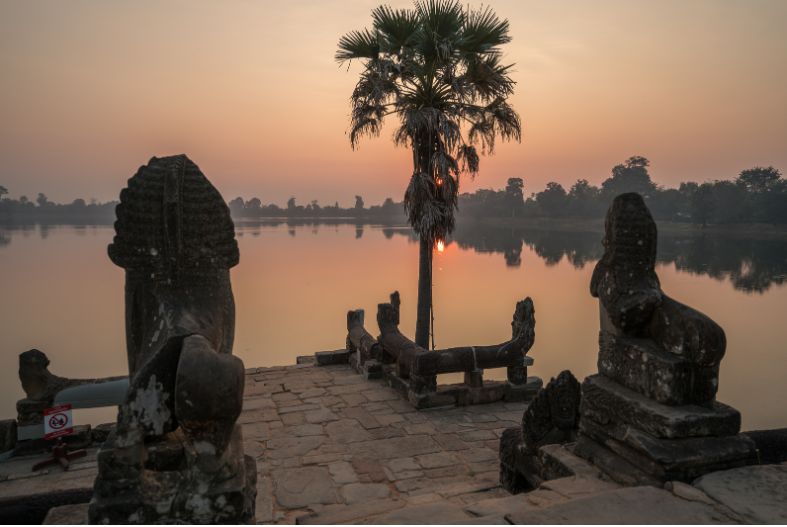

Srah Srang is a tranquil and scenic reservoir located just across from Banteay Kdei. At the edge of the lake is a landing terrace featuring carvings of guardian lions and balustrades in the shape of serpents.
The terrace is a peaceful and scenic spot where visitors can enjoy serene views, particularly during sunrise and sunset. Honestly there isn’t much to do here, but it’s a nice place to stop for a few moments to rest.
Prasat Kravan
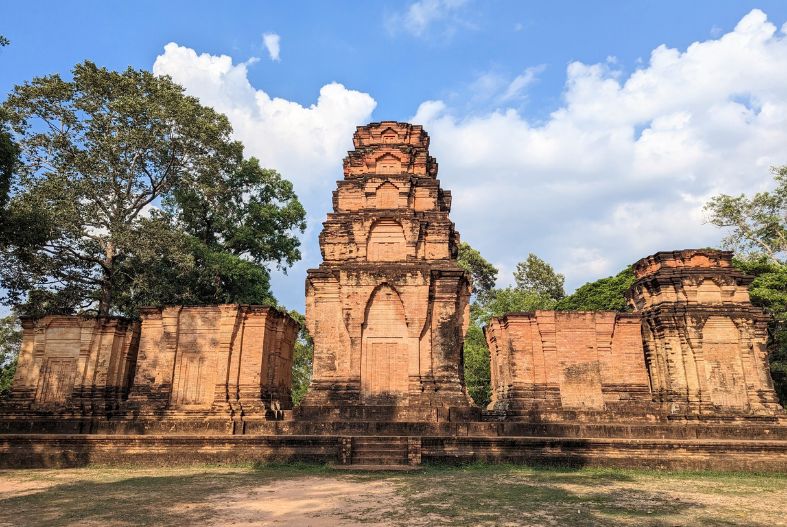

Prasat Kravan is a small yet remarkable temple dedicated to the Hindu god Vishnu. Built during the 10th century by King Harshavarman I, Prasat Kravan is renowned for its unique and well-preserved brick carvings.
The temple consists of five reddish brick towers adorned with intricate bas-reliefs that depict scenes from Hindu mythology. The central feature of the temple is the reliefs of Vishnu and Lakshmi on the interior of two of the towers.
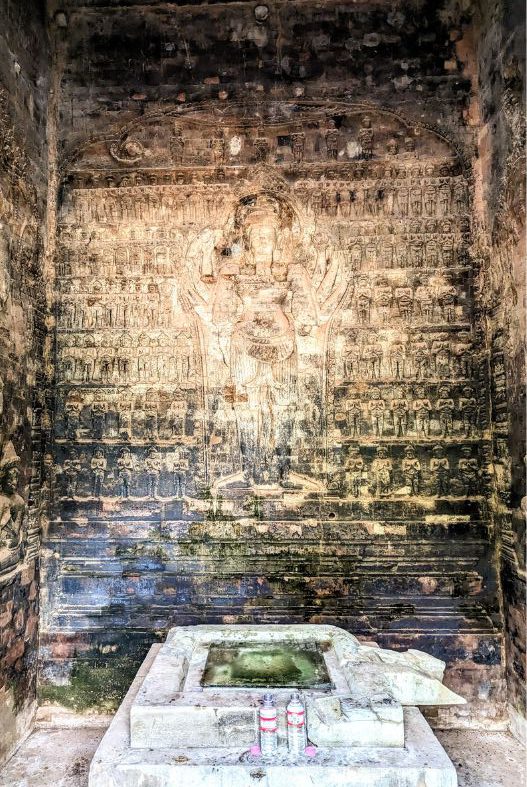

The carvings at Prasat Kravan showcase a level of artistry and detailing that is rarely seen in other temples of its size, making it a significant example of early Khmer architecture and craftsmanship.
If you have the time, this temple is best seen in the morning when the reliefs are lit by the early sun in the east. They can be much more difficult to see in the afternoon.
This is a quick visit and took us no more than 15 minutes.
Ta Keo
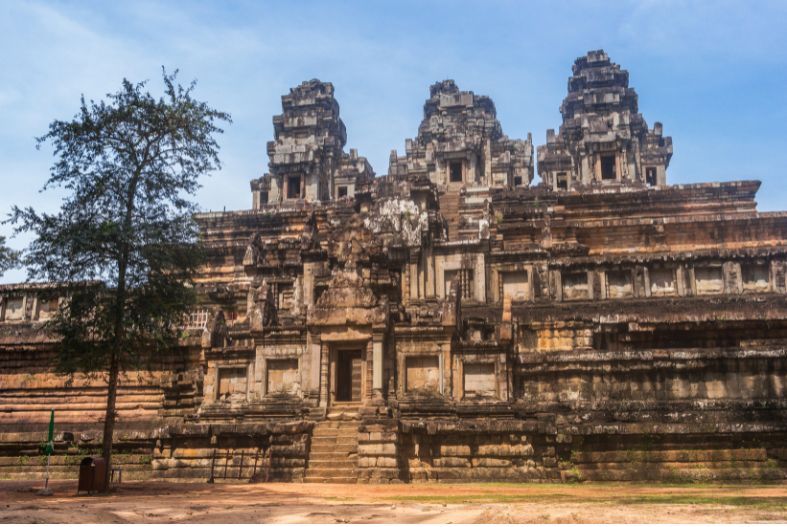

Tucked away down a short dirt path, Ta Keo is one of the lesser visited temples in the area, perhaps partly because it is unfinished. The temple does not have elaborate carvings and decorations, although the exact reason that work halted on the temple is unclear.
The temple’s ambitious design features a massive five-tiered pyramid, soaring to a height of about 165 feet and making it one of the tallest temples in Angkor Wat.
Visitors can climb the steep stairways to the upper tiers, providing panoramic views of the surrounding jungle and other nearby temples.
Even without the flair of decorations, this is a very impressive temple to visit. And it offers a good chance to get away from the crowds!
Final Thoughts
While in Siem Reap you absolutely cannot miss the opportunity to tour the Small Circuit of Angkor Wat. You will be left awestruck by both the magnitude and the intricacies of these ancient temples.
I firmly believe that this is something that everyone should experience at least once in their life. We can promise that is a trip you won’t soon forget!
Other posts you might be interested in:
A Complete Guide to the Angkor Wat Grand Circuit
The Ultimate 3 Day Siem Reap Itinerary
Visiting Siem Reap with Kids (What you NEED to Know Before You Go!)

